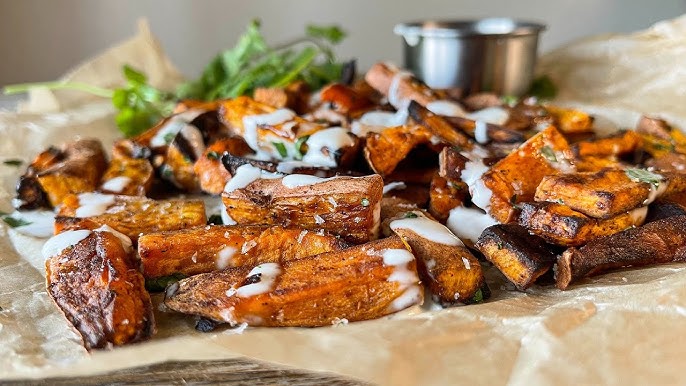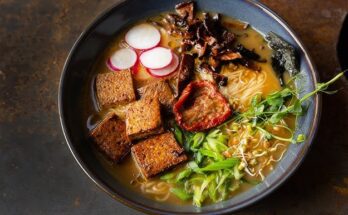Truffle Fries Recipe: Let’s be honest, there’s just something irresistible about crispy fries. Now imagine those fries lightly kissed with earthy, luxurious truffle oil and finished with a sprinkle of freshly grated Parmesan and herbs. That, my friend, is the beauty of truffle fries. It’s not just a side dish—it’s an elevated experience that can steal the spotlight from even the fanciest main course.
Whether you first tasted them at a trendy bistro or saw them on your Instagram feed, truffle fries have become a modern-day comfort food with a gourmet twist. And guess what? You don’t need to shell out $12 for a tiny portion at a restaurant—you can absolutely make them at home, easily, and for a fraction of the cost.
This guide is designed to take you through the entire process—from selecting the right ingredients to achieving restaurant-level crispiness—all in your own kitchen. Let’s dive in and turn simple potatoes into golden, flavor-packed truffle fries that will have everyone asking for seconds (or thirds).
Ingredients You’ll Need
Getting the ingredients right is half the battle when making any recipe. Truffle fries are all about simple, high-quality ingredients. Since we’re not using complex seasonings or sauces, each ingredient has to shine on its own. Here’s what you’ll need:
Main Ingredients
- Potatoes: Go for Russet or Yukon Gold potatoes. These have a higher starch content, which helps them get that beautifully golden crispiness. Avoid waxy potatoes like red potatoes as they tend to get soggy.
- Truffle Oil: This is the star of the show. Choose a good-quality truffle oil—white truffle oil for a lighter, garlicky note or black truffle oil for a deeper, earthier flavor.
- Parmesan Cheese: Freshly grated Parmesan works wonders here. It melts slightly on the hot fries and blends beautifully with the truffle aroma.
Optional Add-ins
- Garlic: If you love bold flavor, minced garlic or garlic powder adds a delicious kick.
- Fresh Herbs: Chopped parsley or thyme gives the dish a pop of color and a hint of freshness.
- Truffle Salt: For an extra punch of truffle flavor, sprinkle a little truffle salt in addition to the oil.
Tools & Equipment Needed
No fancy gadgets are required here, but the right tools make the process smoother and help you achieve consistent results:
- Deep Fryer or Heavy-Bottomed Pot: For frying the potatoes. You can also bake them if you prefer a healthier method.
- Baking Sheet: Essential if you’re going the oven-baked route. A wire rack on top of the sheet helps with air circulation.
- Mandoline or Sharp Knife: For cutting even-sized fries. Consistent thickness ensures they cook evenly.
- Mixing Bowls: For tossing the fries in oil and seasoning without making a mess.
- Paper Towels or Clean Kitchen Towels: To dry the fries thoroughly before cooking.
Pro tip: Keep a slotted spoon or spider strainer handy if you’re frying—makes it easier to fish the fries out without burning yourself.
Preparation Tips Before You Start
Before you jump into slicing and frying, there are a few things you should do to set yourself up for success. These small steps can make a big difference in how crispy and flavorful your truffle fries turn out.
Choosing the Right Potato
Russet potatoes are the top choice for a reason—they’re starchy and fry up incredibly crispy. Yukon Golds work too, offering a creamier center and slightly more flavor. Try to avoid red potatoes or new potatoes, which are too waxy and won’t get that crunchy texture you’re aiming for.
Pre-soaking Potatoes
This is the golden rule for making perfect fries. Soak your cut potatoes in cold water for at least 30 minutes (or even overnight in the fridge). This draws out excess starch, which can make fries soggy. The result? Fries that are crispy on the outside and fluffy on the inside.
Importance of Drying for Crispiness
Once the soaking is done, it’s absolutely crucial to dry the potatoes thoroughly. Use a clean kitchen towel or paper towels and pat them completely dry. If the fries are wet, they’ll steam instead of fry, and you’ll end up with limp fries. No one wants that.
Step-by-Step Guide to Making Truffle Fries
Now, onto the good part: making the actual truffle fries. Follow these steps closely, and you’ll be amazed at how gourmet your kitchen smells by the end of it.
Step 1: Peel and Cut the Potatoes
Start with Russet or Yukon Gold potatoes for the best crispiness. Peel them if desired, then slice into ¼-inch-thick fries. Try to keep them uniform so they cook evenly.
Step 2: Soak and Dry
Place the cut fries in a bowl of cold water and soak for at least 30 minutes to remove excess starch. Drain well and pat completely dry with paper towels—this helps achieve a crisp, golden texture.
Step 3: Fry or Bake the Potatoes
For frying, heat oil to 350°F (175°C) and fry in batches until golden brown. For baking, toss fries in a little oil and bake at 425°F (220°C) for 25–30 minutes, flipping halfway through.
Step 4: Drizzle Truffle Oil
Once cooked, toss the hot fries in 1–2 teaspoons of truffle oil—just enough for that earthy aroma without overpowering.
Step 5: Add Cheese and Garnish
Sprinkle generously with grated Parmesan, salt, and chopped parsley. Serve immediately for that crispy, luxurious bite—restaurant-level perfection right at home!
Oven vs Deep Fryer: Which is Better?
Let’s be honest—this question comes up a lot, especially when you’re trying to decide between indulgence and convenience. Here’s a breakdown of how the two methods compare when it comes to making truffle fries:
Flavor and Texture Comparison
- Deep Fryer: Produces ultra-crispy fries with a soft, fluffy center. The double-fry method is key here. The rich taste and golden texture mimic what you’d get at a high-end restaurant. The downside? More oil, more cleanup, and it’s not the healthiest choice.
- Oven Baked: Still crisp (especially with the right techniques), but slightly less indulgent. You’ll need to bake at high heat and ensure even spacing. The fries will be a bit drier but still delicious, especially when paired with truffle oil and Parmesan.
Health Considerations
- Frying: Let’s face it, frying means more fat. Even with draining and blotting, you’ll consume more oil than with baking.
- Baking: A much lighter option. You control the oil amount, and there’s less grease overall. Perfect for those watching their intake but still craving something fancy.
Which One Wins?
It depends on what you’re going for:
- Want maximum crispiness and restaurant-style taste? Go with the deep fryer.
- Prefer a healthier alternative that’s still super satisfying? Oven baking is your friend.
Either way, truffle oil is the great equalizer. It brings that signature flavor to both versions, so you really can’t go wrong.
How to Make Truffle Fries Extra Crispy
Let’s be honest: soggy fries are a total letdown. Whether you’re baking or frying, getting that crispy texture is everything. Here are the tricks that separate good fries from unforgettable fries.
Double-Frying Technique
This method is a total game-changer:
- First Fry: Cook the fries at a lower temperature (around 325°F). This softens the inside and cooks the potato through.
- Rest: Let them cool for a few minutes. This resting period helps firm them up.
- Second Fry: Crank up the heat (375°F) and fry again for 2-3 minutes until crispy and golden.
Why does this work? The first fry cooks the inside without browning, and the second fry crisps up the outside—think of it like building a crunchy shell around a soft center.
Cornstarch Trick
Another cool hack? Toss your soaked and dried fries in a tablespoon of cornstarch before cooking. It creates an ultra-thin coating that crisps up beautifully, especially in the oven.
Don’t overdo it—just a light dusting is enough. You’ll get fries that are golden, crunchy, and begging to be devoured.
Extra Tips for Crispiness
- Don’t overcrowd the pan or baking sheet—crowding causes steam, not crisp.
- Always use hot oil (not warm!) if frying.
- Serve immediately—fries lose crispiness the longer they sit.
Best Truffle Oils to Use
Not all truffle oils are created equal. Some are luxurious and aromatic, while others are synthetic and overpowering. Since truffle oil is the defining ingredient in this recipe, choosing the right one can make or break your dish.
White vs. Black Truffle Oil
- White Truffle Oil – Made from white truffles, this oil has a garlicky, slightly sweet, and delicate flavor. It’s perfect for those who enjoy subtle, refined notes in their fries.
- Black Truffle Oil – This is deeper, muskier, and more intense. It brings an earthy richness and bold aroma, making it ideal for those who like a more dramatic flavor punch.
If you’re new to truffle oil, start with white—it’s a bit easier on the palate. But if you’re cooking for truffle lovers, black truffle oil offers a gourmet, restaurant-style depth.
Recommended Brands
Here are some high-quality, chef-favorite truffle oils that are worth every penny:
- Urbani Truffle Oil – Known for authenticity and top-tier Italian truffle products. A bit pricey, but unmatched in aroma.
- La Tourangelle White Truffle Oil – Made with real white truffle and sunflower oil. Smooth and aromatic, and widely available.
- Truff Black Truffle Oil – A stylish, modern pick that blends real truffles with a subtle spice note.
- Sabatino Tartufi Truffle Infused Oil – A reliable brand with great balance between quality and price.
Avoid oils with labels like “truffle essence” or “truffle flavoring” as these often use synthetic aromas. Always check the ingredients list.
How to Store Truffle Oil
Once opened, store truffle oil in a cool, dark place—preferably in the fridge if you live in a warm climate. It’s best used within 4 to 6 months for peak flavor. Over time, the aroma can fade, so don’t wait too long to use it up!
Serving Suggestions
Sure, truffle fries are amazing on their own, but why stop there? With the right pairings, they can become the star of any meal—or the perfect companion to something equally delicious.
What to Serve with Truffle Fries
- Gourmet Burgers – Think juicy beef or veggie patties topped with caramelized onions and goat cheese.
- Grilled Steak or Chicken – The earthy flavor of the fries complements smoky meats perfectly.
- Fried Egg – Add a fried egg on top for a decadent brunch option.
- Aioli Dips – Truffle fries and garlic aioli are a match made in heaven. Try lemon, sriracha, or roasted garlic variations.
How to Plate for Maximum Appeal
Presentation matters, especially when you’re serving guests or just want to treat yourself. Try these tips:
- Use parchment paper in a small metal basket or bowl for that “gastropub” look.
- Sprinkle a little extra Parmesan and herbs on top right before serving.
- Serve with dipping sauces on the side in ramekins—adds flavor and aesthetic.
You can even drizzle just a bit more truffle oil right before serving if you want the aroma to really pop when the fries hit the table.
Variations on Truffle Fries
Once you’ve mastered the basic truffle fries, the sky’s the limit. Whether you’re catering to dietary needs or just feeling adventurous, here are a few fun spins on the classic:
Vegan Truffle Fries
Yes, you can absolutely enjoy truffle fries without the dairy!
- Skip the Parmesan and use nutritional yeast or vegan cheese shreds instead.
- Make sure your truffle oil is vegan (some are flavored with dairy-based infusions).
- Top with fresh herbs like rosemary and parsley for extra flavor without the cheese.
These are just as satisfying, and you won’t miss the cheese one bit.
Loaded Truffle Fries with Bacon
Take your truffle fries to cheat-day level with some serious toppings:
- Crispy bacon bits
- Melted cheddar or Gruyère cheese
- Chopped scallions or caramelized onions
- Truffle ranch dressing or aioli drizzle
You basically turn them into gourmet poutine without the gravy. Perfect for game day or when you’re hosting friends.
Spicy Truffle Fries with Chili Oil
If you like heat, this one’s for you. Add a dash of chili oil or red pepper flakes along with the truffle oil. You get the same rich umami flavor but with a fiery twist. Great with sriracha mayo on the side.
Common Mistakes to Avoid
Even the best-intentioned cooks can slip up when making truffle fries. Here’s what to look out for so you don’t ruin a good batch:
Overusing Truffle Oil
This is the #1 mistake. Truffle oil is strong—too much and your fries will taste like chemicals. Stick to 1 to 2 teaspoons per batch, and always drizzle after cooking, never before.
Undercooking the Fries
If the fries are pale and limp, you probably didn’t cook them long enough or skipped the double-frying step. Make sure your oil is hot enough and that you fry in small batches to avoid lowering the temperature.
Not Seasoning Immediately
Always season fries while they’re hot. That’s when salt and cheese stick best. If you wait too long, the flavor won’t adhere, and you’ll end up with bland fries.
Skipping the Soak
It might seem like an extra step, but soaking removes excess starch and is key to that crispy texture. Don’t skip it—your fries will thank you.
Storage and Reheating Tips
Let’s be real—leftover fries are rarely as good as fresh ones. But if you’ve made a big batch, here’s how to store and revive them without losing all that crispiness and flavor.
How to Store
- Let fries cool completely before storing.
- Keep in an airtight container lined with paper towels to absorb moisture.
- Store in the fridge for up to 3 days.
How to Reheat
- In the Oven: Spread on a baking sheet and reheat at 400°F for 5–7 minutes until hot and crispy.
- In an Air Fryer: Heat at 375°F for 3–4 minutes.
- Avoid microwaving—this makes them soggy and lifeless.
You can re-drizzle with a touch of fresh truffle oil before serving to revive that rich aroma.
Nutritional Information
While truffle fries feel like a decadent indulgence (and let’s be real, they are), it’s still helpful to know what you’re consuming. Here’s a general breakdown for a standard serving, though exact numbers can vary depending on cooking method and toppings used.
Calories per Serving
For one serving of homemade truffle fries (roughly 1 cup cooked):
- Calories: 250 – 400 kcal
- Total Fat: 14 – 20g (depending on oil and cheese)
- Saturated Fat: 3 – 6g (from Parmesan)
- Carbohydrates: 30 – 40g
- Protein: 3 – 6g
- Fiber: 3 – 4g
- Sodium: 200 – 400mg (can be higher with added salt/cheese)
Macros Breakdown
| Macro | Amount (per serving) |
|---|---|
| Carbohydrates | 35g |
| Fats | 18g |
| Protein | 5g |
| Fiber | 3g |
Remember, the nutritional value can shift based on the amount of oil used, whether you deep fry or bake, and the quantity of toppings added (cheese, bacon, etc.). To keep it on the lighter side, bake your fries and go easy on the cheese and oil.
Are Truffle Fries Healthy?
In moderation, they can be part of a balanced meal. While they’re not a “superfood,” using quality ingredients like olive oil-based truffle oil, fresh herbs, and baked potatoes can make this treat a little less guilty. Pair with a lean protein or a big salad to round things out.
FAQs about Truffle Fries Recipe
1. Can I use frozen fries for this recipe?
Yes, absolutely! While fresh-cut fries deliver the best texture and flavor, frozen fries work in a pinch. Bake or fry them according to package instructions, then toss with truffle oil, Parmesan, and herbs while hot.
2. Is truffle oil vegan?
Most truffle oils are vegan since they’re typically made with olive or sunflower oil and synthetic truffle aroma. However, always check the label—some may include dairy-based additives. If you’re making vegan truffle fries, also skip the Parmesan or use a plant-based version.
3. What’s the difference between truffle salt and truffle oil?
Truffle salt is regular salt infused with bits of dried truffle or truffle essence. It adds both saltiness and earthy flavor. Truffle oil, on the other hand, is an oil infused with truffle aroma. Use both sparingly to avoid overpowering your dish—they pack a punch!
4. Can I air-fry truffle fries?
Definitely! Air frying is a great alternative to deep frying. Preheat your air fryer to 375°F, lightly coat fries with oil, and cook in batches for 15–18 minutes, shaking halfway through. Then toss with truffle oil and toppings. You’ll get crispy, delicious results with less oil.
5. How long does truffle oil last once opened?
Truffle oil should be used within 4 to 6 months after opening for best flavor. Store it in a cool, dark place—ideally in the refrigerator to preserve its aroma. If it starts to smell off or loses its fragrance, it’s time to replace it.
Conclusion
And there you have it—the ultimate, step-by-step guide to making mouthwatering, gourmet-style truffle fries right in your own kitchen.
From choosing the right potato to perfecting the crispiness and nailing the truffle oil drizzle, each step brings you closer to that restaurant-worthy experience. Whether you’re serving them with a burger, impressing dinner guests, or just treating yourself on a Friday night, truffle fries never disappoint.
What’s even better is how customizable they are—go vegan, make them spicy, load them with toppings, or keep it classic. Once you’ve mastered the base recipe, the possibilities are endless.
So grab some potatoes, pour a little truffle oil, and treat yourself to the most irresistible fries you’ve ever made. Trust me, you’ll never look at regular fries the same way again.



